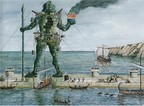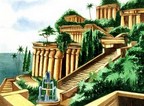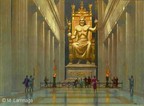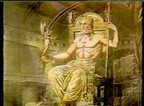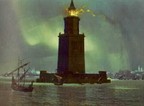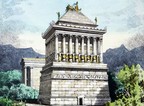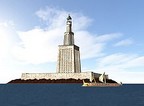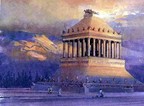1. The Great Pyramid
The giant pyramid is the oldest of the seven wonders of the Ancient World, and the only one that survives up to this date. It was the tallest structure on earth and it was retained like this for its first 4,000 years.
Royal tomb
The Great Pyramid was built to become the grave of “Khufu”. He was one of the pharaohs, the kings of ancient Egypt. The tomb was completed around 2580 BC. He later built two more pyramids, one for his son and the other for his grandson and some smaller ones for their wives.
The construction of pyramids
The pyramids are located at the ancient cemetery of Giza, on the bank of the Nile River. Archaeologists estimate that it took 20 years and the work of some 100,000 people to build the Great Pyramid of Khufu and that more than 2 million stone blocks weighing 2.5 tons each were used. The workers carried those using ramps, levers and reels and then adjusted them without using mortar.
Shiny limestone
When he the bulk of the pyramid had finished it looked like a staircase. Following these steps they covered them with blocks of white limestone, which were cut so as to form a glossy surface. They were matched so well that you cannot fit a knife’s blade between them. The final height of the building reached 147 meters. Each side of the Great Pyramid is 230 meters long! It covers an area larger than 9 football fields.
The burial of the pharaoh
The ancient Egyptians believed that after death had to take care of the body of the dead, in order for that spirit to survive. Internal organs were removed, the rest of the body covered with minerals and wrapped with gauze. The body was a mummy. The mummy was buried together with clothes, food, jewelry and other useful things for the afterlife. The mummy of Cheops was placed in a burial chamber inside the pyramid.
2. The Hanging Gardens of Babylon
The Hanging Gardens of Babylon was the most famous attraction of this city. Archaeologists have identified findings that may have been part of the Gardens, but they are not completely sure. Their existence is known from the descriptions of people who had seen them during the ancient era.
Nebuchadnezzar and Amytis
Greek and Roman authors describe that the gardens were built around 600 BC by order of Nebuchadnezzar II. Babylon was built on the banks of the Euphrates River, south of Baghdad, the Iraqi capital. It is said that the king gave the order for the hanging gardens to be built because the young Queen Amytis, who came from the mountains of Persia, missed her homeland.
Watered terraces
The Hanging Gardens were built rather close to the river Euphrates. It consisted of successive terraces, where the highest must have 40 feet high. There was growing every kind of tree and plant, transported by oxcart from every region of the empire. Among them there were figs, almonds, chestnuts, pomegranates, roses, lilies, and fragrant shrubs. There was a very good street system that constantly fed the plants with water from the Euphrates. The water of the system was raised in containers by slaves who would carry them with their hands or by mangle! Then the water went down to the lower tiers of waterfalls and technical grooves, always keeping the soil moist.
3. Temple of Artemis at Ephesus
Croesus was the last king of Lydia, a region of Asia Minor. He was known for his many riches. In 560 BC he commanded that a magnificent temple at Ephesus was built. It is said that Ephesus, a Greek city, was built by the Amazons.
The Biggest Marble Temple
Croesus decided to build the temple in honor of the goddess Artemis. She was the goddess of the moon and protector of wild animals and girls. The temple was built with marble and limestone materials that were transported from the surrounding hills. There were 120 marble columns supporting the main part of the temple. Each column had a height of 20 meters. Huge boulders were moved there with pulleys and were connected with metal pins. After the completion of the roof, artists decorated the building with wonderful carved images. In the middle of the temple there was the marble statue of Artemis. The temple was the largest of the classical world, much bigger than the Parthenon in Athens that was built later. The base of the foundation was 131 m long and 79 m width
Irostratos and Alexander
Two hundred years later, in 356 BC the temple was destroyed by fire. Irostratos, someone who wanted this way to become famous had put the fire. By coincidence, at the day of destruction of the temple, Alexander the Great was born. Later, Alexander visited Ephesus and gave order to build the temple again, at the same position.
The final destruction
The Temple of Alexander survived until the third century AD. Over the years the mud flooded the port of Ephesus and the city ended up unimportant. The Goths then ransacked the temple and completed the destruction of the flood. Today what remains of the temple in Ephesus is a few blocks of the foundations and a single restored column.
4. Statue of Zeus at Olympia
3000 years ago, Olympia was a very important religious center in southwestern Greece. The ancient Greeks worshiped Zeus, king of the gods, the latest form of worship came through sports and games. The first Olympic Games were organized in 776 BC since then and over 1100 years, the games took place every 4 years.
The temple of Zeus
In the 5th BC century BC, the citizens of Olympia decided to build a temple to honor Zeus. The grand building was built between 466 and 456 BC, constructed from solid stone blocks and columns. For a few years after its completion there was no statue of Zeus, until they decided to make one. The construction of the statue was commissioned to the famous Athenian sculptor Phidias.
The construction of the statue
The sculptor Phidias, already had made two other superb statues in Athens, dedicated to the goddess Athena. In Olympia Phidias and his colleagues first made a wooden building to serve as a skeleton of the statue. Then they covered it with plates of ivory to depict the bare skin of the god and put gold leaf on his clothes. The artists covered the connections so well that the statue appeared to have been made by one piece alone. The statue was placed on a throne with inlaid ebony ornaments and precious stones. When completed it reached a height of 13 feet and its head nearly reached the roof of the temple. It gave the impression that if Zeus got up he would sweep up the roof off! On the walls of the temple platforms were built enabling visitors to admire up close the face of the God. After its completion in 435 BC the statue was for the next 800 years one of the greatest wonders of the world.
The kidnap of the statue
Around 40 AD the Roman emperor Caligula commanded that the statue was moved in Rome. But according to tradition, when the workers arrived to dismantle the statue, it took out a laugh so glaring, that they were scattered by fear. Later, in 391 AD with the rise of Christianity, the Romans forbade the Olympic Games and the Greek temples were closed. Then the statue of Zeus was transferred to Constantinople. In 462 AD a fire destroyed the palace, where the statue stood, thus it became permanently lost.
During the 6th AD century the site of Olympia was shaken by earthquakes. The temple and the stadium were destroyed by landslides and floods, and mud covered what remained. Beneath the mud the remains preserved, which in our time have been discovered by archaeologists. Today, visitors can visit the ruins of the temple and the location of the statue.
5. The Mausoleum of Halicarnassus
Mausolus was a ruler of Caria, a vassal to the Persian Empire from 377 until 353 BC Its Capital was the Greek city of Ionia, Halicarnassus. He succeeded his father on the throne, but managed to shake off the Persian yoke.
The mausoleum
Mausolus, married his sister Artemisia. When he gathered wealth and power he designed a tomb for himself and his queen. A tomb so magnificent, that would remind everyone about his glory over the centuries. However, Mausolus died before finishing his work, which was completed by Artemisia around 350 BC .The name mausoleum comes from the very name of the king and it has stayed like this even today for every state grand tomb like Lenin’s Mausoleum in Moscow.
The Lion guards.
The ashes of the royal couple were placed in golden vessels in the burial chamber at the base of the building. Stone lions guarded the chamber. Above the strong stone base was erected a structure similar to an ancient Greek temple, surrounded by columns and statues. At the top of the building there was a tiered pyramid and onto it, at a height of 43 meters above the ground, a statue of a chariot was erected, which was dragged by horses. Inside the tank there were perhaps the statues of the king and queen.
Earthquake disaster
Eighteen centuries later, a terrible earthquake destroyed the mausoleum. In 1489, Christian Knights of St. John took the materials to build the nearby fort. Some walls of the fortress were built by green boulders that once flanked the main part of the Mausoleum. Some years later the Knights discovered the burial chamber of Mausolus and Artemisia. But one night they left him unattended, resulting in the plundering by pirates and the theft of all the gold and other valuables there were.
Excavation statues
It was another 300 years until the area was explored by archaeologists. They excavated parts of the foundations of the Mausoleum and found statues and other sculptures that had remained intact. Among them large statues were identified, which probably represent the king and queen. In 1857 they were moved to the British Museum in London and they are still there. In recent years there have been more excavations, and so far some stones are left to resemble the glory of ancient Mausoleum of Halicarnassus.
6. The Lighthouse of Alexandria
In the third century BC a lighthouse was built to guide ships safely to the port of Alexandria. During the night it reflected glow of a big fire and during the day in the sky it raised a big column of smoke. This was the first lighthouse in the world and remained in place for 1500 years.
The lighthouse island
The building was built on a small island called Pharos (lighthouse), in front of Alexandria, Egypt. This famous city was built by Alexander the Great according to a project of the architect Dinokrates, when he conquered Egypt. The building was named after the island.
It took probably 20 years until it was built and it was completed around 280 BC during the reign of Ptolemy II. The building of the lighthouse was designed by architect Sostratis.
The three towers
The lighthouse consisted of three marble towers, built upon a foundation of stone blocks. The first tower was four-sided and it contained apartments for the workers and soldiers. From up there a second octagonal spiral ramp led up to the last tower.
Brilliant Light
The last tower was a cylinder-shaped one and inside it there was a burning fire which led ships safely to the port. Above it there was the statue of the Saviour Zeus. The total height of the lighthouse was 117 meters.
The polished brass mirror
For the maintenance of fire huge amounts of fuel were needed. It was fed with wood, carried through the spiral ramp by horses and mules. Behind the fire there were brass sheets which reflected the glow at the sea. The ships could distinguish it from 50 kilometers away. In the twelfth century the port of Alexandria was filled with mud and ships were no longer using it. The lighthouse fell into disuse. Perhaps the leaves of bronze mirror became detached and cut into coins. In the fourteenth century an earthquake destroyed the lighthouse. Some years later the Muslims used the materials to build a fort. This fort was rebuilt and it still stands in place of the first lighthouse in the world.
7. The Colossus of Rhodes
The Colossus was a gigantic statue erected in the harbor of Rhodes. In antiquity the Rhodians sought permanently to preserve their independence, engage in trade and not to participate in the wars of other Greek cities. Nevertheless they were conquered several times.
God of sun
At the end of the 4th Century BC the Rhodians celebrated a great victory. Demetrius Poliorketes after a year long siege was eventually forced to flee and leave behind much of his equipment. The Rhodians decided to sell the equipment of Demetrius and used the money to erect a beautiful statue in honor of the god Helios (Sun) who protected them.
The brass statue
We do not know exactly how the statue was at what point or set it up. We do know, however, that was constructed from brass and had a height of 33 meters. It was designed by the architect Harry and It took 12 years to complete.
The city port
The brass sleeve was secured onto an iron frame. The statue was hollow inside and as it progressed, construction workers filled the gaps with heavy stones to ensure stability. The Colossus was completed around 280 BC. For centuries, people listening about the Colossus, thought it stood over the entrance of the harbor of Rhodes, with its feet apart. But this was practically impossible, because the entrance to the harbor of Rhodes was some 400 meters wide and the Colossus was not that … colossal! The texts allow us to assume that was probably placed at the center of town and watched over the sea and the harbor.
The Colossal Crash
Around 226 BC, less than fifty years after its completion, the colossus fell by an earthquake which shook and cut its knees. An oracle advised the Rhodians not to reinstall it, so they left it lying on the ground. It remained in this position for 900 years and many visitors saw the fallen statue of the god Helios. In 654 AD a Syrian prince conquered Rhodes and stripped the statue of its bronze plaques. It is said that he took them to Syria using 900 camels. The brass was sold to merchants who melted it and cut it into coins.
